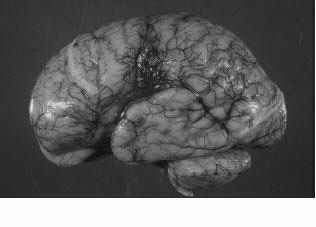Also referred to as a ‘smooth brain’, it a condition of cortical dysgenesis in which cellular layers are improperly formed and thus the cerebral cortex lacks the typical convolutional pattern formed by gyri and sulci (see figure below). One mutant gene that gives rise to lissencephaly is LIS1 that has been mapped on to chromosome 17p13, resulting in four layers overlying a thin strip of white matter, instead of the usual six. Another mutant has been mapped on to the long arm of chromosome X. Males with this condition have severe mentally retardation, similar to those who have mutations in the LIS1 genes. Females with X-linked lissencephaly typically have a milder condition, presumably resulting from a mosaic of random inactivation of either the wild-type or mutant C-chromosome. Cortical defects like lissencephaly have been linked to deficits in integrins in mice studies. In general, this severe malformation manifests itself not only with profound mental retardation, but also with epileptic seizures.
